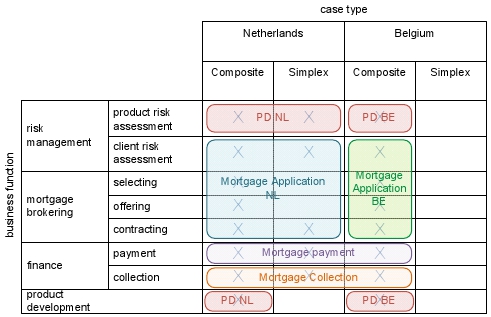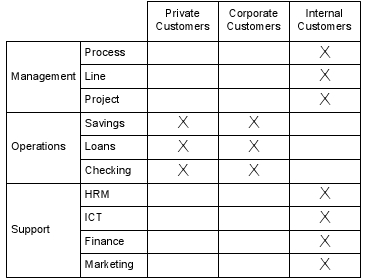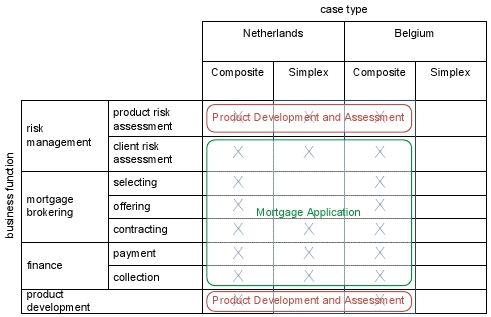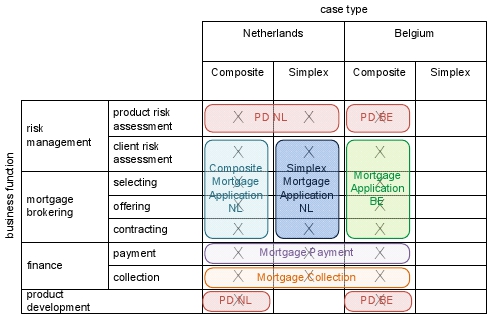2.2 Designing a Process Architecture
General
- Processes can be in a consumer-producer relationship.
- One process provides an output that the other process takes as an input.
- Process Architecture levels
- Level 1: Process landscape model, very abstract.
- Level 1 element points to concrete level 2 business process
- Should be understandable. Not more than 20 categories of business processes of a company.
- All employees should be able to relate to it with their daily work, and accept it as a consensual description of the company.
- Dijkman approach (see further).
- Level 2: Shows more granularity than level 1, still quite abstract.
- Level 2 element points further to a business process model on level 3.
- Level 3: Shows detail of the processes.
- Including: control flow, data inputs/outputs, assignment of participants.
- Level 1: Process landscape model, very abstract.
Dijkman Model

Architecture along two dimensions:
Case Type: Type of cases handled by an organization. (product or service delivered to external customers or other internal departments)
- Horizontal displayed.
- Classified according to properties (see a paragraph down)
Business Function: Something an organization does.
- Vertical displayed.
- Hierarchical decomposition of functions:
- Function consists of Sub-Functions which can consist of Sub-Sub-Functions etc.
- Ex: Purchasing function -> Vendor selection + Operational Procurement
- Steps to create this model:
- Identify Case types
- Identify Functions for case types
- Construct One or more case/functions matrix`s
- Identify Processes
Step 1. Identify Case Types
- Selecting case properties that will be used for the classification.
- Purpose: Determine different ways in which (similar) processes are handled.
- Properties that make processes behave differently (different steps) should be included in the classification.
- Properties used to classify:
- Product/Service type: Home insurance, car insurance, life insurance.
- Channel:
- Contact medium: Telephone, face-to-face, internet.
- Or location: Europe, North-America.
- Customer type (customers dealt with): Frequent flyers, regular travelers.
- Cases would be then classified by combining the previous:
- Home insurance via telephone, home insurance via face-to-face, car insurance via telephone.
- Purpose: Determine different ways in which (similar) processes are handled.
- RESULT: List with Case Types
Step 2. Identify Functions For Case Types & Construct a case/function matrix.
- Classification of the business functions that are performed on the different case types.
- Each case type need to be identified in detail.
- Use a reference model.
- Interview different people within the organization.
- Purpose: Check if reference model applies to the organization or to identify functions.
- With: Employees involved, product and service managers.
- Different people may use different terms for similar business functions.
- Avoiding terminological issues from the start.
- When a functional separation of the departments needs to be harmonized along for ex. different locations, management structures also need to change with it.
- RESULT: Matrix of which business function(s) associate with which case type(s).

Step 3. Construct Process Landscape Model
- A cell in the matrix contains a 'X' if the corresponding functions can be performed for the corresponding case types.
- Group different processes.
- Make the matrix`s so that all Xes are covered. You can use multiple matrices to increase readability.
- RESULT: One or more Basic Process Landscape Models

Step 4. Identify Processes
- Which combinations of business functions and case types form a business process.
- Trade-off between:
- All X`s are different processes.
- The entire matrix is one process.
- General rule: Entire matrix is one big process which will only be split up in case certain rules/guidelines apply.
- Guidelines to finish the identifying the process:
- If a process has different flow objects, it can be split up vertically.
- Flow object = A product/service/object that the process activities are carried out on.
- If the flow object of a process changes multiplicity, the process can be
split up vertically.
- When some one task has a single flow object at a time, and another task has a batch you are better of splitting up the process.
- If a process changes state, it can be split up vertically.
- In particular, we distinguish:
- Initiation state: Contact between customer and provider.
- Negotiation state: Customer and provider negotiate about the terms of service/delivery etc.
- Execution state: The provider delivers the product or service
- Acceptance state: Customer and provider negotiate about acceptance and payment of the delivery
- In particular, we distinguish:
- If a process contains a logical separation in time, it can be split up vertically.
- Parts are performed at different time intervals
- ex. Once per customer request, once per day, once per month, once per year
- If a process contains a logical separation in space, it can be split up horizontally.
- If the process is performed differently at multiple locations.
- There must be a difference in the way processes are handled at multiple locations. Just separation in space is not enough to make separation in space a must.
- If a process contains a logical separation in another relevant dimension, it can be split up horizontally.
- There has to be no choice why a processes needs to be performed differently across logical units.
- Another relevant dimension other than time and space.
- If a process is split up in a reference model, it can be split up.
- A reference model is usually a best practice solution. So why not use that?
- If a process covers (many) more functions in one case type than in
another, it can be split up horizontally.
- If with different case types, in the same process, there is a difference in the number of functions the process can be split up.
- See Composite Mortgage Application NL and Simplex Mortgage Application NL in the figure below.
- If a process has different flow objects, it can be split up vertically.
- RESULT: One or more finished Process Landscape Models
